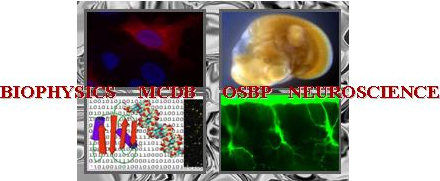Interdisciplinary Graduate Programs Symposium

2013 OSU Molecular Life Sciences
Interdisciplinary Graduate Programs Symposium

Talk abstracts
Abstract:
During neurodegenerative diseases, such as amyotrophic lateral sclerosis (ALS), astrocytes have been identified as mediators of motor neuron (MN) death. Up to now, it is unknown what molecular mechanisms account for astrocyte mediated toxicity in ALS. ALS astrocytes have been shown to be immunologically active and neurotoxic with many attributes that are also common to the innate immune system. In order to kill and eliminate pathogens, cells of the innate immune system, such as natural killer (NK) cells mostly utilize three well described defense mechanisms. They encompass 1) the release of pro-inflammatory molecules, 2) activation of the Fas death receptor pathway, or 3) activation of the granule exocytosis pathway composed of pore forming protein, perforin (PRF1) and cell death-inducing proteases granzyme B (GZMB). In ALS, modulation of the inflammatory process in astrocytes, as well as inhibition of functional binding of Fas ligand to their receptor has revealed minimal to no benefits to MN survival in numerous in vitro and in vivo studies and, up to date, all have failed to demonstrate clinically meaningful benefits. However, the relevance of the granule exocytosis pathway for ALS pathology has not yet been explored. Here we demonstrate that both in vitro and in vivo mouse ALS astrocytes actively release PRF1 and GZMB, followed by PRF1 pore-mediated delivery of GZMB into MN. Substantial amounts of PRF1 and GZMB were also found within MNs in spinal cord sections of human FALS/SALS post-mortem tissue. Finally, suppression of PRF1 or GZMB expression in mouse and human FALS and SALS astrocytes resulted in an almost complete protection of MNs during in vitro co-culture. Our results uncover a new disease mechanism in which astrocytes use killing pathways typically ascribed to the innate immune system, and identify these mechanisms as targets for therapeutic intervention in ALS.
References:
1.Haidet-Phillips, A.M., et al. Astrocytes from familial and sporadic ALS patients are toxic to motor neurons. Nat Biotechnol 29, 824-828 (2011).
2.Garden, G.A. & La Spada, A.R. Intercellular (mis)communication in neurodegenerative disease. Neuron 73, 886-901 (2012).
3.Glass, C.K., Saijo, K., Winner, B., Marchetto, M.C. & Gage, F.H. Mechanisms underlying inflammation in neurodegeneration. Cell 140, 918-934 (2010).
4.Andersen, M.H., Schrama, D., Thor Straten, P. & Becker, J.C. Cytotoxic T cells. J Invest Dermatol 126, 32-41 (2006).
5.Philips, T. & Robberecht, W. Neuroinflammation in amyotrophic lateral sclerosis: role of glial activation in motor neuron disease. Lancet Neurol 10, 253-263 (2011).
Keywords: ALS, Perforin, GranzymeB